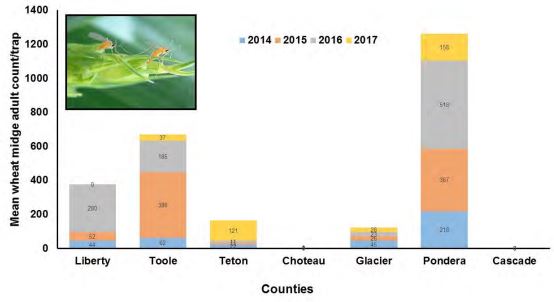Monitoring of wheat midge and its parasitoid Macroglenes penetrans in irrigated and dryland spring wheat in Golden Triangle, Montana
Principal Investigator: Gadi V.P. Reddy
Project Personnel: Govinda Shrestha, Ramadevi L. Gadi and Dan Picard
Western Triangle Agricultural Research Center, Montana State University, 9546 Old Shelby Rd., P.O. Box 656, Conrad, MT 59425, USA
Aim of the Study
The aims of this study were: 1) to determine the wheat midge population dynamics in irrigated and dryland spring wheat fields in the Golden Triangle area, Montana and 2) to monitor the wheat midge parasitoid M. penetrans population, in irrigated and dryland spring wheat fields in the Golden Triangle, Montana.
Materials and Methods
Wheat midge populations
Western Triangle Agricultural Research Center team installed 12 delta traps baited with wheat midge pheromone lures (2S, 7S)-nonadiyl dibutyrate in spring wheat fields (dryland and irrigated) at different locations (Pondera, Toole, Choteau and Teton Counties). Wheat midge pheromone delta traps were installed from during the first-second week of June, 2017. They were monitored nearly at 1-2 days interval from Monday to Friday in Pondera (Ledger, Valier and WTARC) and Toole (Ledger), while at 15 days interval in Choteau and Teton Counties. Trap monitoring work was completed from last week of July to first week of August, 2017.
Parasitoid Macroglenes penetrans population level
The M. penetrans adult population level was monitored in traps installed in dryland and irrigated spring wheat fields located at Valier, WTARC and Ledger locations. Sweep net method was used to sample the adult parasitoids from each field. About 120 sweeps were made per field and the collected samples were stored at -20 °C until processing. The parasitoids were identified under a microscope (Doane et al., 1989). Parasitoid adults were monitored at 3-4 days interval throughout wheat midge adult activity period. The sweep net sampling was began in June 20 and completed in July 20, 2017.
Results
Wheat midge population trend in the Golden Triangle areas of Montana
Total cumulative midge count observed in our trap established locations are shown in Table 1. In 2017, wheat midge populations were monitored in seven counties (Liberty, Toole, Teton, Choteau, Glacier, Cascade and Pondera). Portion of the wheat midge count data was extracted from Pestweb Montana. Total number of wheat midge pheromone traps installed in wheat fields were 46 in 2017. Among the seven counties, the highest wheat midge population level was recorded in Pondera County in comparison to no presence of wheat midge in Cascade County (Fig 1). The second highest wheat midge populations were noticed at Teton County followed by Toole, Glacier, and Chouteau Counties (Fig 1). Compared to the last year, wheat midge populations were generally at low irrespective of County, except in Teton County where population levels increased sharply this year.
|
County |
Field name |
Lat |
Lng |
Total cumulative count/trap |
Parasitoid observed |
|
Pondera |
WTARC irrigated |
48.31395 |
-111.9253 |
282 |
Yes |
|
Pondera |
WTARC dryland |
48.31392 |
-111.92575 |
83 |
Yes |
|
Pondera |
Cory Crawford Irrigated |
48.30644 |
-112.15416 |
211 |
Yes |
|
Pondera |
Cory Crawford dryland |
48.30819 |
-112.0913 |
670 |
Yes |
|
Pondera |
Terry Peters dryland |
48.24878 |
-111.69696 |
315 |
Yes |
|
Toole |
Terry Peters dryland |
48.25049 |
-111.59902 |
34 |
Yes |
|
Pondera |
Jodi Hobel dryland |
48.30131 |
-112.1201 |
34 |
Yes |
|
Pondera |
Jodi Hobel irrigated |
48.2861 |
-112.0552 |
387 |
Yes |
|
Teton |
Scott Inbody dryland |
47.9112 |
-112.03736 |
108 |
No |
|
Choteau |
Knees dryland |
47.99638 |
-111.36411 |
2 |
No |
|
Pondera |
Kyle Dean dryland |
48.38166 |
-112.25097 |
126 |
Yes |
|
Pondera |
Kyle Dean irrigated |
48.4317 |
-112.1848 |
461 |
Yes |
Table 1. Total cumulative wheat midge count observed in Pondera, Toole, Choteau and Teton Counties of Montana
Figure1. Wheat midge population trends at the Golden Triangle area of Montana from 2014- 2017
Wheat midge population level: Irrigated vs. dryland spring wheat fields
Generally, wheat midge populations were relatively at lower levels in dryland compared to irrigated spring wheat fields. At both cropping systems, the flight activity of wheat midge adults started at about the same date June 15-21, in 2017 (Fig 2). However, wheat midge peak population levels were recorded slightly earlier (June 25- 29) in dryland system while in the later period (June 29-July 1) in irrigated system. In addition, wheat midge emergence was observed until late period (July 10) in irrigated system while for a short period (July 5) in dryland system.
Figure 2. Wheat midge adult activity based on pheromone trap catch in dryland and irrigated spring wheat fields
Figure 3. Wheat midge parasitoid, Macroglenes penetrans adult population level in dryland and irrigated spring wheat fields, 2017.
Parasitoid population level: Irrigated vs. dryland spring wheat fields
As expected, M. penetrans population was found at higher levels in irrigated compared to dryland spring wheat midge infested fields (Fig 3). At both cropping systems, the emergence of parasitoid has begun nearly at the same time (June 29 - July 5, 2017) (Fig 3). The total cumulative parasitoid number ranged and 11-22 and 45-73 in the dryland and irrigated cropping system, respectively.
Acknowledgements
This work was supported by Montana Wheat and Barley Committee. We would like to thank summer intern Bert Paulsen for assistance with field work.
Reference
Doane, J.F., DeClerck-Floate, R., Arthur, A.P., 1989. Description of the life stages of Macroglenes penetrans (Kriby) (Hymenoptera: Chalicidoidea, Pteromalidae), A parasitoid of the wheat midge, Sitodiplosis mosellana (Gehin) (Diptera: Cecidomyiidae). Can. Entomol.
121, 1041–1048.



